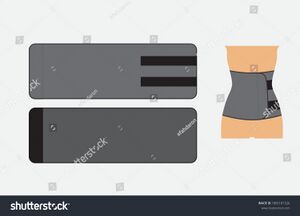Abdominal binder
Introduction[edit | edit source]
ABs are a noninvasive application in clinical practice to the reduction of postoperative pain and improve physical function.[1] The Elastic abdominal binder is used by clinicians to relieve pain, improve pulmonary function, and stabilize an incision to enhance wound healing. After upper abdominal surgeries widely patients suffer from restriction of respiratory function. Using of abdominal binder is useful.[2]some evidence presented that abdominal binders promote coughing and deep breathing after surgery and mobility. The elastic abdominal binder has a positive effect on abdominal postoperative pain and recovery.[3]
Clinicians assigned randomly one hundred and nine women diagnosed with cervical,
endometrial, or ovarian cancer, who had done abdominal surgery into two groups: the intervention (56 patients) used the abdominal binder from day 1, and the control (53 patients) did not wear the binder. The primary outcomes were pain and functional recovery. The Researcher observed the intervention group significantly lower pain score than the control group.[3]
Some researchers concluded no significant difference between both groups in the surgical outcome and no difference in the number of days staying in the hospital but only a difference in the degree of comfort.[4]
Indications[edit | edit source]
- After cesarean delivery.[5]
- Postoperative Gynecological Cancer.[3]
- After incisional hernia repair.
- Postoperative colonoscopy. [6]
- Spinal cord injuries.[7]
- Orthostatic hypotension.[8]
Types[edit | edit source]
Elastic abdominal binder and non-elastic abdominal binder. Elastic abdominal binders are more helpful and suitable than non-elastic binders after surgeries.[9]
Physiotherapy[edit | edit source]
D. MacLean adds an abdominal binder in the chest physical therapy for intubated patients in ICU who are unable to cough. Voluntary cough is correlated with high expiratory airflow with contraction of the rib cage and abdominal muscles .when add abdominal binder as splinting for abdominal muscle. simultaneous compression of the abdomen and chest increases the intrapleural pressure and then increases expiratory airflow than produced by chest compression alone.[10]
mostly after abdominal surgery patients wake up from anesthesia wearing an abdominal binder. Very important to get the right size of the binder. To detect your size, measure the widest part of your body. Usually for women widest part is the hips. For men, usually the waist. [11]
References[edit | edit source]
- ↑ Xin Sun, MD, Qingchuan Wei, MD, Chenying Fu, PhD, Qing Zhang, MD, Zejun Liang, MD, Lihong Peng, MD, Li Chen, PhD, Chengqi He, PhD, Quan Wei, PhD, Effects of Abdominal Binders on Postoperative Pain and Functional Recovery: A Systematic Review and Meta-Analysis, Pain Medicine, Volume 22, Issue
- ↑ Cheifetz, O., Lucy, S. D., Overend, T. J., & Crowe, J. (2010).The effect of abdominal support on functional outcomes in patients following major abdominal surgery: a randomized controlled trial . Physiotherapy Canada. Physiotherapie Canada, 62(3), 242–253.
- ↑ 3.0 3.1 3.2 Chantawong, N., & Charoenkwan, K. (2021). Effect of Elastic Abdominal Binder on Pain and Functional Recovery Following Gynecologic Cancer Surgery: A Randomized Controlled Trial. Medicina (Kaunas, Lithuania), 57(5), 481.
- ↑ Choi, H. U., Park, S. H., Lee, E. J. S., Jung, K. U., Shin, J. H., & Lee, S. R. (2021). Effect of abdominal binder after laparoscopic cholecystectomy on enhanced recovery: a randomized controlled trial. Journal of minimally invasive surgery, 24(2), 91–97.
- ↑ Paasch, C., Santo, G., Aljedani, N., Ortiz, P., Bruckert, L., Hünerbein, M., Lorenz, E., & Croner, R. (2021). The Effect of an Abdominal Binder on Postoperative Pain After Laparoscopic Incisional Hernia Repair–A Multicenter, Randomized Pilot Trial (ABIHR-I) of the Intraperitoneal Onlay-Mesh Technique. Deutsches Arzteblatt international, 118(37), 607–613.
- ↑ Yu, G. Q., Huang, X. M., Li, H. Y., Tang, W., Hu, D. M., Lü, M. H., & Fu, K. I. (2018).Use of an abdominal obstetric binder in colonoscopy: A randomized, prospective trial . Journal of gastroenterology and hepatology, 33(7), 1365–1369.
- ↑ Julia, P. E., Sa'ari, M. Y., & Hasnan, N. (2011). Benefit of triple-strap abdominal binder on voluntary cough in patients with spinal cord injury. Spinal cord, 49(11), 1138–1142.
- ↑ Figueroa, J. J., Singer, W., Sandroni, P., Sletten, D. M., Gehrking, T. L., Gehrking, J. A., Low, P., & Basford, J. R. (2015). Effects of patient-controlled abdominal compression on standing systolic blood pressure in adults with orthostatic hypotension. Archives of physical medicine and rehabilitation, 96(3), 505–510.
- ↑ Zhang, H. Y., Liu, D., Tang, H., Sun, S. J., Ai, S. M., Yang, W. Q., Jiang, D. P., & Zhang, L. Y. (2016). The effect of different types of abdominal binders on intra-abdominal pressure. Saudi medical journal, 37(1), 66–72.
- ↑ MacLean, D., Drummond, G., Macpherson, C., McLaren, G., & Prescott, R. (1989). Maximum expiratory airflow during chest physiotherapy on ventilated patients before and after the application of an abdominal binder. Intensive care medicine, 15(6), 396–399.
- ↑ https://www.healthline.com/health/abdominal-binder







